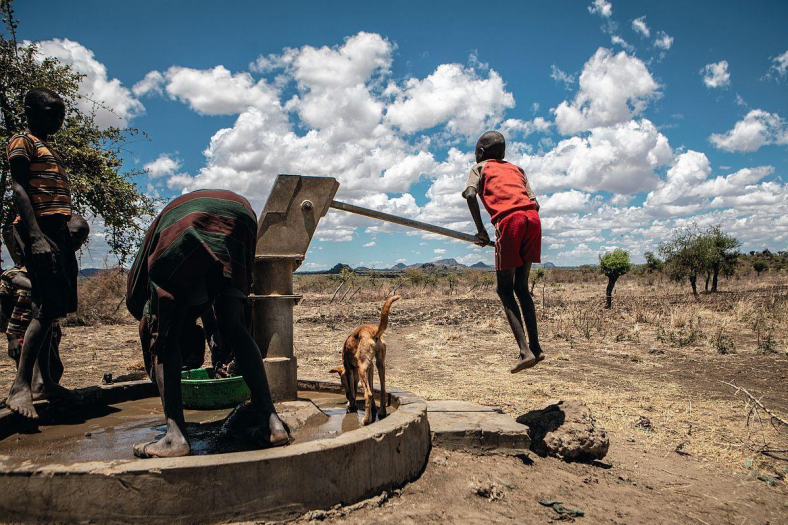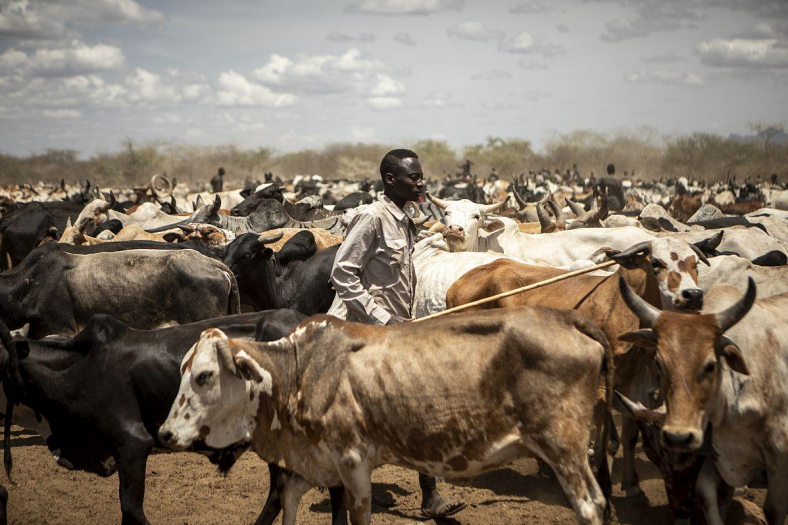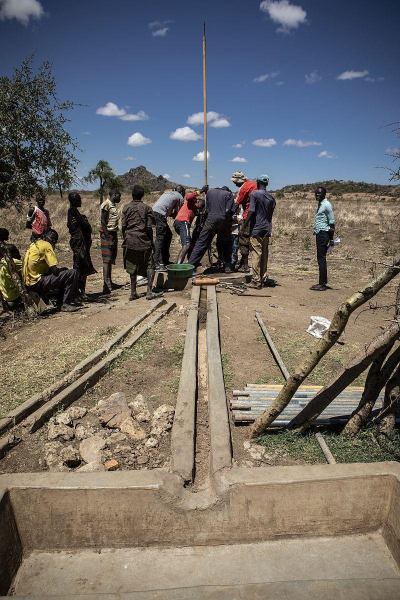These livestock keepers are the canaries in the coal mine of a planet in crisis

Imagine our planet without its oceans for a moment and consider the land area that remains. No less than half of it are rangelands, where pastoralists move around with their livestock. Many of them live in Africa, and their way of life is falling victim to the climate crisis. “We get much less milk from our cows than we used to. And that has everything to do with the unreliability of the rain.”
This article was translated by Kompreno, with support from DeepL. Original Source, published in September 2022.
They live scattered throughout the Sahel region, from west to east, all the way to the Horn of Africa: pastoralists who may or may not have fixed homesteads. Their lives and herds follow the rains along set routes, the way they have done for centuries. Invariably dependent on the whims of nature, they live in the continent’s most inhospitable places. They provide food for millions of people. But the food crisis in the Horn of Africa reveals the limits of their way of life.
Today, after three failed rainy seasons, there is simply no water left, and livestock are dying. Seven million animals have reportedly died already, the United Nations has calculated. What happens when the herds are gone? “Supplies have run out. The cattle are dead. Hunger is what remains,” Omar Mohamoud Qayaad tells us, speaking from Somaliland in Eastern Africa.
“Supplies have run out. The cattle are dead. Hunger is what remains,”
Omar Mohamoud Qayaad
In the Horn of Africa, 20 million lives are threatened by that hunger. It is the result of climate change, which these people have not contributed to themselves.
Is livestock farming in Somaliland doomed? Qayaad, who works for the Horn Migrants Support Organisation (HOMSO), hopes that he will not have to answer that question. At present, 64 percent of Somaliland’s inhabitants still make a living from livestock keeping. However, he sees that young people are turning away. “They prefer to opt for paid work in the city.” But that city is supplied with meat and dairy products by the pastoralist communities.
To protect the fragile ecosystems of rangelands, the herds must be allowed to graze them. Even the United Nations recognises the great importance of this, declaring 2026 the International Year of Rangelands and Pastoralists. But those same pastoralists would rather not wait that long to emphasise how valuable their way of life is.

Good for the planet
Pastoralists are often described as experts in adaptation. That adaptability should be a strength, now that rains and the seasons are increasingly difficult to predict. But that is precisely why they are also the canary in the coal mine of our planet in crisis.
“It’s true that we are used to drought,” says Shoba Liban of the non-profit organisation Pastoralist Women Health and Education in Kenya. “But when it gets too dry, you have to travel further and further to find water and grass. The number of conflicts is increasing, and the number of pastoralists giving up their way of life has become very high.” This is a disturbing trend, as meat and dairy products remain important sources of food in her country as well. In fact, demand is rising sharply, according to the United Nations.
Although the global livestock population is responsible for 14.5% of the greenhouse gases emitted, the production method of pastoralists is, in fact, not a burden on the planet. “We manage our limited resources extremely sustainably,” Liban clarifies. “Meat is dried to avoid waste, and our yogurt, for example, can be stored for two to three months.”
“Not every form of livestock keeping is bad for the planet,” affirms Anthony Denayer of the Belgian NGO Vétérinaires Sans Frontières. “The current figures on emissions are mainly based on intensive livestock farming in industrialised countries.” Intensive livestock farming involves using as little land as possible for as many animals as possible. According to Denayer, that cannot be compared to extensive livestock farming, where the animals graze very large areas.
“Extensive livestock keepers only have a limited impact on the environment, or even a positive one,” Denayer emphasises. “They make sustainable use of vast grazing areas. This form of livestock keeping also protects the many endangered plant and animal species in these ecosystems. And we know today that it can stimulate carbon sequestration in the soil. That can compensate for greenhouse gas emissions.”
He is referring to what happens when the roots of plants die: the carbon absorbed by the plants is stored in the soil. That means it does not end up in the atmosphere and so it does not increase global warming.
That this form of livestock keeping is proving to be of great importance in the fight against climate change is also a message that several spokespeople from pastoralist communities are trying to spread. “We stay in one location for two or three days. As our herds move, they restore fragile ecosystems, and their manure fertilises the land,” explains one of the leading voices among African pastoralists, Hindou Oumarou Ibrahim of the Association of Peul Women and Autochthonous Peoples of Chad (AFPAT) in central Africa. “We follow the rhythm of the seasons, giving nature space to recover. When we leave, the land is more fertile than before, thanks to our ancestral, ecological farming practices.”
Lake Chad contains 90 percent less water today than it did in the 1960s, and that raised Hindou Oumarou Ibrahim’s alarm years ago. “When I was a child, cows were milked twice a day during the rainy season. During the dry season, it was once, either in the morning or in the evening. Now we do it once every two days. This has everything to do with the unreliability of the rain, a consequence of global warming. The rainy season is getting shorter and shorter. The rain that does fall comes more often in torrential floods, simply washing away the vegetation.”
Driven off their own land
So 2026 is to be the year of rangelands and pastoralists, at Mongolia’s suggestion, as the UN General Assembly decided early this year. Rangelands are of inestimable importance for biodiversity, and this message is now being heard at international level. It seems that sustainable pastoralism is key to protecting these rangelands.
Unfortunately, the pastoralist communities themselves have had little or no involvement in policy for far too long. Their way of life was easily dismissed as primitive and of little value. “We are more than mere inhabitants of a wasteland,” should be the message, according to Shoba Liban, the Kenyan activist.
“We are more than mere inhabitants of a wasteland,” Shoba Liban
Pastoralists have been using community land for centuries. The use of grazing land still has little legal basis in many countries. Land rights must be returned to the communities, argues the Chadian activist Hindou Oumarou Ibrahim. “The International Year is an opportunity to really involve communities in decision-making,” she says hopefully. Demographic growth, land boundaries and land privatisation have made access to land complex and inequitable in many places.
Conflicts over land and also over water are not new, and consultation among nomadic groups and between herders, crop farmers and fishing communities is traditional in many places. “But that authority of our elders is always being undermined by the government,” Liban observes. In practice, “local officials and police officers, for example, do not accord legal value to verbal agreements that communities enter into with each other.”
In Loliondo in northern Tanzania, the government and the Maasai are in conflict. As recently as June this year, members of the Maasai were forcibly evicted by authorities. This illustrates how fragile the rights of pastoralists are. For more than a decade, the government has been trying to evict some 70,000 Masai from their natural pastures.
An area of more than 1,500 square kilometres has since been assigned to a United Arab Emirates company, Otterlo Business Corporation. It organises hunting parties for one of the richest people on earth: Sheikh Mohammed bin Rashid al-Maktoum, Emir of Dubai, Prime Minister, Vice President and Minister of Defence of the United Arab Emirates.
Stronger together
Countries seeking to adapt to climate change would do well to better protect the land rights of pastoralists. For example, the establishment of a Community Land Association (CLA) in the south of Uganda’s turbulent Karamoja sub-region has proven to be successful. At least that’s what district official Emmanuel Lomongin thinks. He is in charge of natural resource management in the neighbouring district, Kaabong.

Hindou Oumarou Ibrahim: “The rainy season is getting shorter and shorter. The rain that does fall comes more often in torrential floods, simply washing away the vegetation.”
Herve Bossy (Vétérinaires Sans Frontières)
A CLA of this kind means that representatives of different communities decide together on everything that goes on above ground. This decision-making process is based on local traditions, but the CLA formalises it. This gives the decisions more legal and political weight.
The Ugandan government does retain the ability to make decisions about what is under the ground and thus grant mining concessions to interested commercial players. But more CLAs have been established in southern Karamoja by local groups or communities. And these have been further united in a trust, Rucodet, representing a total of 35,000 pastoralists.
The trust unites the communities in a region where divisions often run deep. Now even mining companies can no longer get past Rucodet, says Anthony Denayer of Vétérinaires Sans Frontières Belgium, the organisation that supports the trust. The community trust brings together the various groups and has already managed to reclaim areas from mining companies or enforce compensation.
In northern Karamoja, there is no such trust yet. But district official Lomongin and Gabriel Achoro of the local NGO Dodoth Agro-Pastoralist Development Organization (DADO) are already involving the communities in very concrete projects that attract great interest today, they explain to MO*.
These include water management projects, for example. With support from the Belgian water NGO Join For Water and from Vétérinaires Sans Frontières Belgium, they are looking for the best ways to use and store their scarce water supplies.
In regions of scarcity, new water sources or irrigation projects can intensify conflicts between communities, research has shown. A report by the NGO Wateraid illustrates, for example, how new wells in northern Tanzania attracted more people and animals. This intense interest quickly exceeded the wells’ capacity. Investment in water collection and access is needed, but in that region, it merely intensified conflicts between crop farmers and herders, rather than resolving them. That is why it is important to manage water in consultation with stakeholders.
“We try to provide support in developing action plans for integrated water management, among other things,” Achoro explains. “For example, constructing sand dams or underground channels to prevent erosion. Those action plans are then recognised by the local authorities and can thus be incorporated into policy.”
Humans, livestock and firearms
Pan Paul Kenye is a member of the local water management committee. He welcomes the investments, because the challenges are great. When he was growing up, his family still had a herd of about 100 cattle. Today, by necessity, his main activity has become crop farming. Kenye lost his last four cows only recently. The first two died of one of the many diseases that are gaining ground in the region due to climate change. Tick-borne diseases such as East Coast fever are on the rise. Foot-and-mouth disease has also wreaked havoc, testifies DADO staff member Gabriel Achoro.
Pan Paul Kenye’s last two cows were stolen by “the neighbours”, however. He is referring here to tensions between Ugandan and Kenyan herders that have once again increased. In north-eastern Uganda, an old conflict is flaring up once more. Karamoja is the driest part of the country, bordering Kenya and South Sudan. It is often referred to as “the land of nomadic herders, cattle and weapons.”
From the late 1970s onwards, however, homemade weapons were replaced by firearms in the region.
Eighty percent of its inhabitants primarily make a living from semi-nomadic livestock keeping. Indeed, not only the Karamojong, but several other communities migrate through the same rangelands, across three national borders. The Turkana, Dodoth, Jie and Teso, like the Karamojong, graze their herds wherever there is grass to be found.
A herd can sometimes consist of more than 1,000 cows and is the most precious asset of a pastoral community. Traditionally, the animals were protected from human and animal intruders with light weapons. In this arid region, access to water and pastures has always been scarce, and conflicts alternated with negotiations as part of the survival strategy.
From the late 1970s onwards, however, homemade weapons were replaced by firearms in the region. In the 1980s, automatic weapons began to circulate increasingly, due to the civil wars in Uganda and South Sudan (then part of Sudan). Livestock raids were not a new phenomenon, but the local arms race cost many animal and human lives.
At the beginning of the millennium, disarmament campaigns were launched in both Kenya and Uganda. But the uneven implementation of that disarmament, especially on the Ugandan side, seems to be causing frustrations. “There are many conflicts again with Kenyan neighbours crossing the borders,” district official Emmanuel Lomongin says. Drought in Kenya has driven several communities back to Karamoja. There are currently negotiations across the borders, Pan Paul Kenye tells us, but for now the situation remains tense.

Herve Bossy (Vétérinaires Sans Frontières)
Tipping point
The effects of the tensions are making themselves felt in the nomadic communities in this part of Uganda. A number of people are simply leaving the rangelands and livestock keeping behind. “You see people migrating to the city in search of work, as labourers for example,” Lomongin testifies. “You also see an increase in the number of child marriages. Because people have financial problems, young daughters are being married off earlier than they otherwise would be.”
“Young people also often start cutting down trees to make charcoal and sell it in town,” Achoro adds. The increase in illegal logging exacerbates problems of erosion. After all, when there are fewer roots to hold the soil together, it washes or blows away more easily and becomes less fertile. It is a vicious cycle that worries him.
Lomongin believes it is possible to find sustainable solutions by bringing communities together in a structure, such as the Rucodet Trust, and by increasing their ownership and control of the communal land.
“Because we have lived in harmony with nature for centuries, we know that protecting nature is an investment in our children’s future,” concludes Hindou Oumarou Ibrahim. “We see enough success stories where farmers, fishermen and herders come up with brilliant solutions.”
In her advocacy work, Ibrahim consistently reminds industrialised countries of their responsibilities, but she also calls for them to learn from the communities affected. “We have come up with solutions that work with nature: to protect sources of fresh water, to identify crops that are more resistant to drought, and to combat both climate change and desertification with sustainable livestock keeping. Indigenous peoples, women and the Sahel region all benefit, and ultimately so will the entire world.”
Maak MO* mee mogelijk.
Word proMO* net als 2798 andere lezers en maak MO* mee mogelijk. Zo blijven al onze verhalen gratis online beschikbaar voor iédereen.
Meer verhalen
-
Report
-
Report
-
Report
-
Interview
-
Analysis
-
Report











 Oxfam België
Oxfam België Handicap International
Handicap International